Words Sarah Langton-Lockton Photographs Neil Brown and Paul Tucker
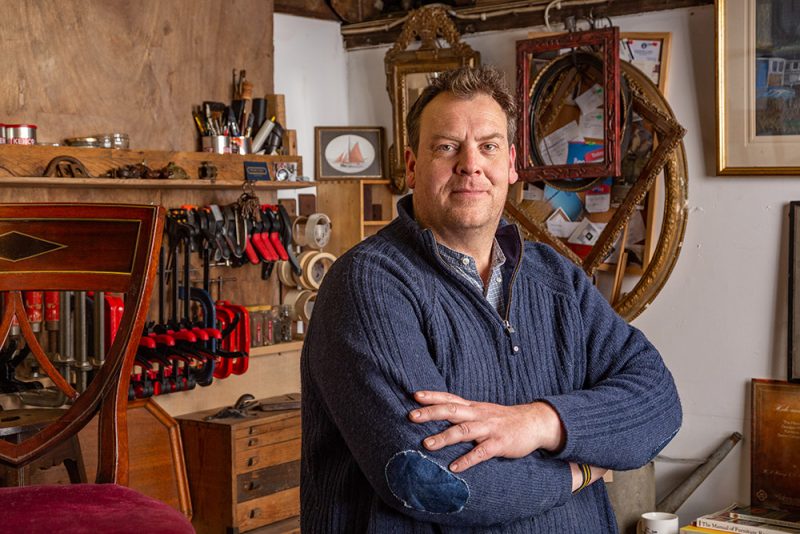
Paul in his workshop
He’s a big man in the Bryn Terfel mode, 6ft 6in tall, with size 16 feet and hands to match, and yet he has the lightest touch when handling the damaged pieces, sometimes fragile, that he mends so sensitively that no repair is visible. Ménage à Bois is the name of Paul’s workshop. It occupies a densely packed corner of the upper floor of Branching Out, the antiques centre that has brightened The Mall in Faversham since July 2018. Among the timber rafters, chairs predominate – a Biedermeier dining chair restored to its original glory, wobbly country chairs that will be carefully dismantled and rebuilt, an unusual hall chair with a back decorated with sea serpents.
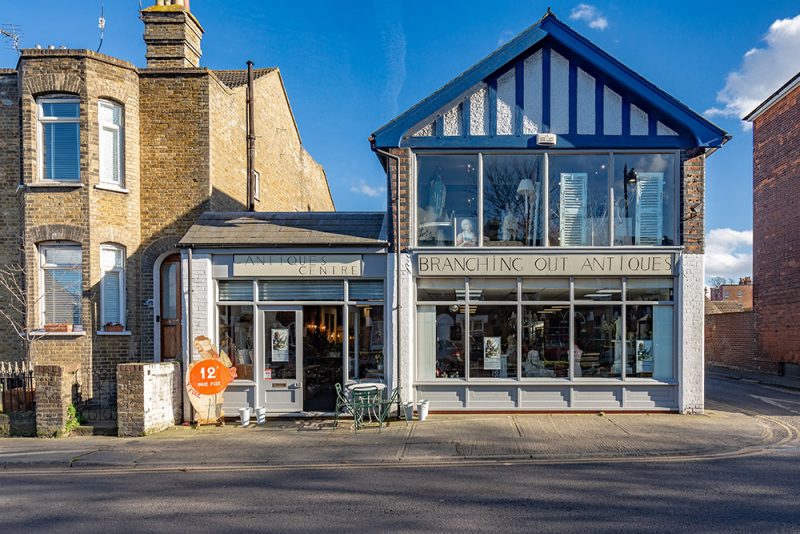
Branching Out Antiques Centre
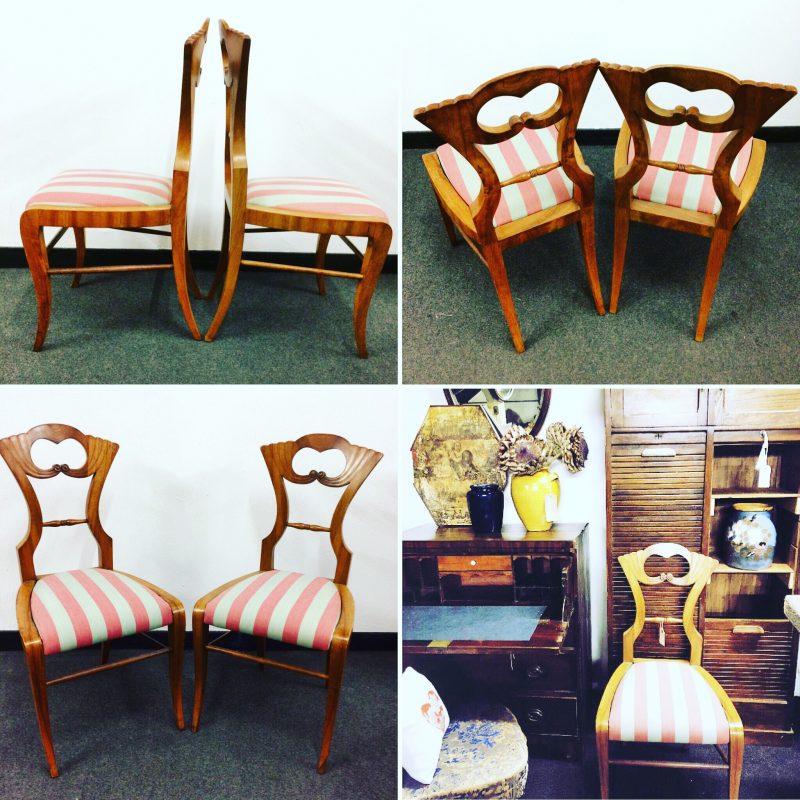
Biedermeier dining chairs
Paul describes the state of the chair when it came into his workshop: ‘The back and legs were loose. To get the back strong again, the chair had to be taken apart. Someone had attempted a repair and used modern glue. This hadn’t worked, but made the job harder to do. The blocks had to be reglued on and new dowels fitted and then coloured out.’ Paul calls this approach ‘the art, not of deception, but of disguise.’ The chair is nearly finished – ‘just one more block to glue on,’ says Paul. In the course of several visits I detect a reluctance to do this – when the job is done the chair will go.
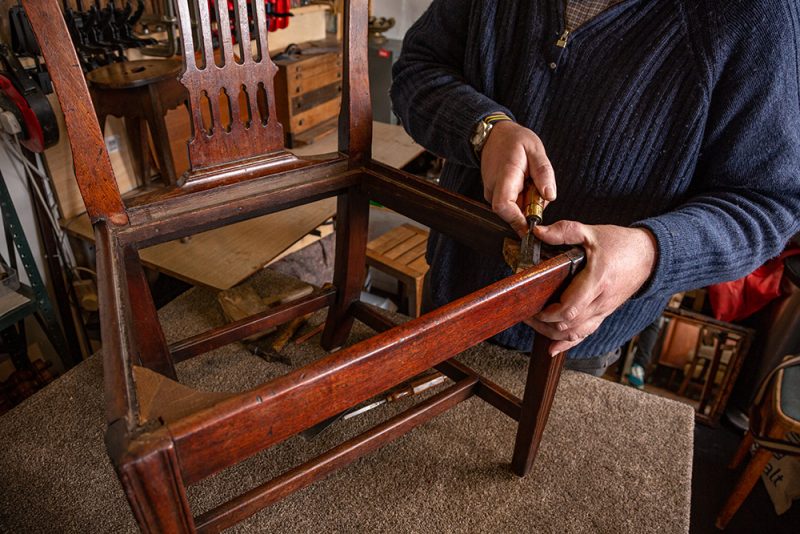
Chairs are carefully deconstructed and rebuilt
‘I think I started out by being fascinated by antique furniture, then pouring my life into it,’ says Paul. He was born in Folkestone and grew up in Westwell Leacon, near Charing, where his parents owned property, including an antiques business. ‘They opened Peckwater Antiques and Interiors in the late 1980s. My dad stripped pine furniture and my mum, who had always been involved with antiques, had her first opportunity to sell country furniture and soft furnishings.’ He learnt from them both. ‘From quite a young age,’ says Paul, ‘I was taught by my parents how a piece of furniture is put together, and then you know how to take it apart.’ In his parents’ house, he says, ‘everything was for sale, with a special scheme label in which letters represented numbers which denoted how much the item had cost, what it was worth and how much it could be sold for.’
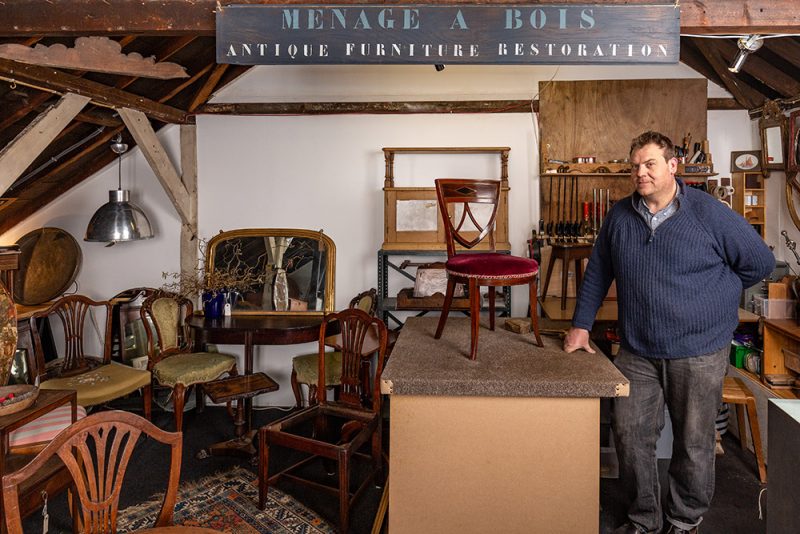
An exquisite French Empire chair
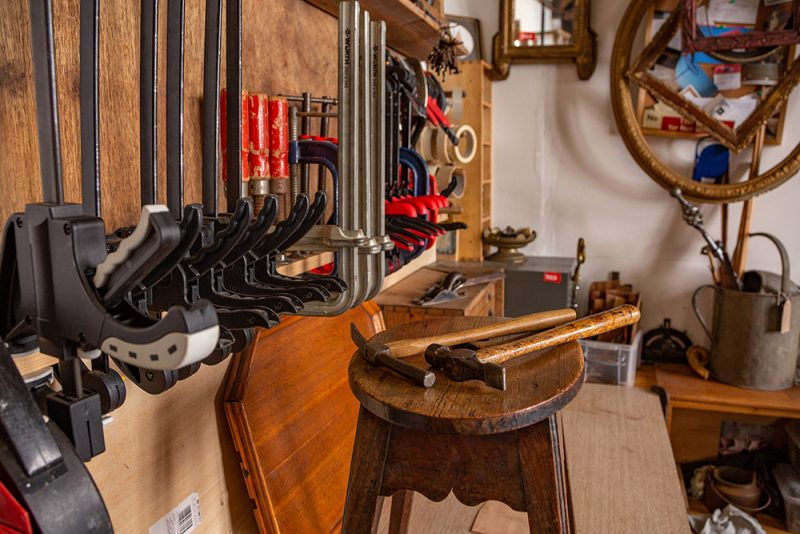
The tools of Paul’s trade include a wall of clamps
Paul lives with his wife Maxine and four children, two boys and two girls, in a Georgian brick house in Ospringe Street, otherwise known as the A2. ‘The house is slowly being shaken to bits’, says Paul, by the lorries that thunder past. ‘A friend who is a surveyor said in no way buy this house’, he says, but the family loves it, it is a family home that reminds him of the house he grew up in and it somehow accommodates a vast amount of furniture – a 13ft dining table and at one point 19 dining chairs. ‘Everything in this house is broken,’ says Paul, ‘but it smells nice’ – Maxine is a dab hand at waxing furniture.
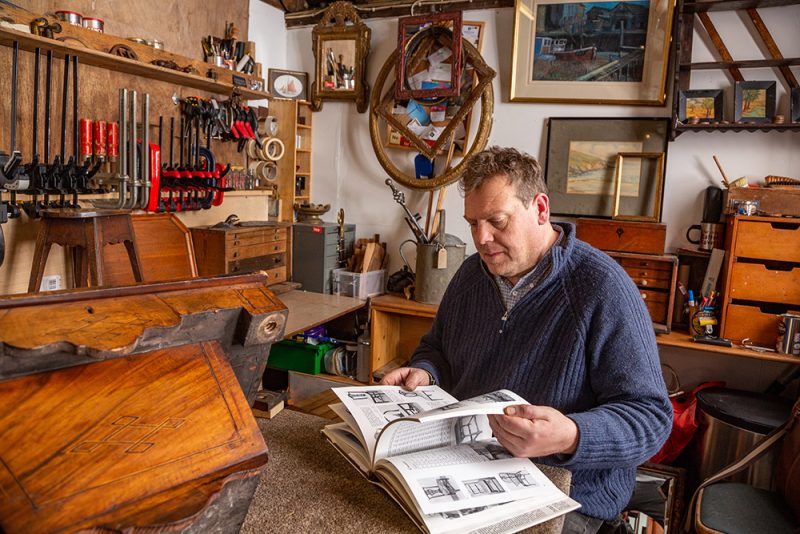
Paul researching chairs
‘We have a rule,’ says Paul, ‘one in, one out,’ but admits that it doesn’t apply to him. ‘I used regularly before Christmas to turn up with a sofa. I used to panic that we didn’t have enough chairs. You have to learn to say no, but on the flip side we have acquired some wonderful things.’ He adds: ‘ I’m forever seeing something I want for the house, but where can I put it? Maxine’s answer is always: “It’s not coming in here, it’s going down the shed.”’ As a result, Paul has five sheds crammed with stuff. He met Maxine when he was 18. ‘She has been part of it all along.’
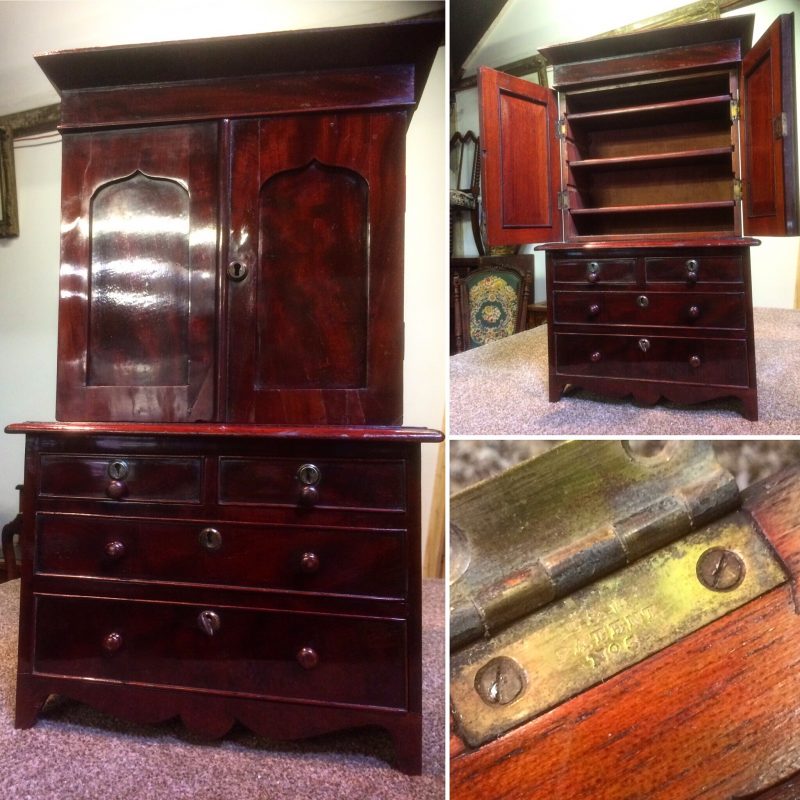
A miniature linen press, an apprentice piece or more probably a travelling salesman piece
But let’s go back a bit. Following an undistinguished career at secondary schooI, which he left at 16 with just a few O levels, Paul embarked on his plan to become a furniture restorer. ‘I was really lucky to know what I wanted to do.’ The much-maligned Youth Training Scheme (YTS) got him on his way. It was the 1980s, the era of Lovejoy on the television and the ‘murky’ practices – Paul’s word – of some dealers. These included the employment of ‘knockers’ whose job was to persuade old ladies to part with heirlooms for a song. One slightly dodgy YTS placement involved Paul spending whole days using nasty chemicals to strip the labels from paint tins. The tins, which contained wax, had been bought cheaply in Europe. The owner attached his own labels and a handsome profit ensued. Paul, working in a confined place without health and safety provisions, would go home high as a kite.

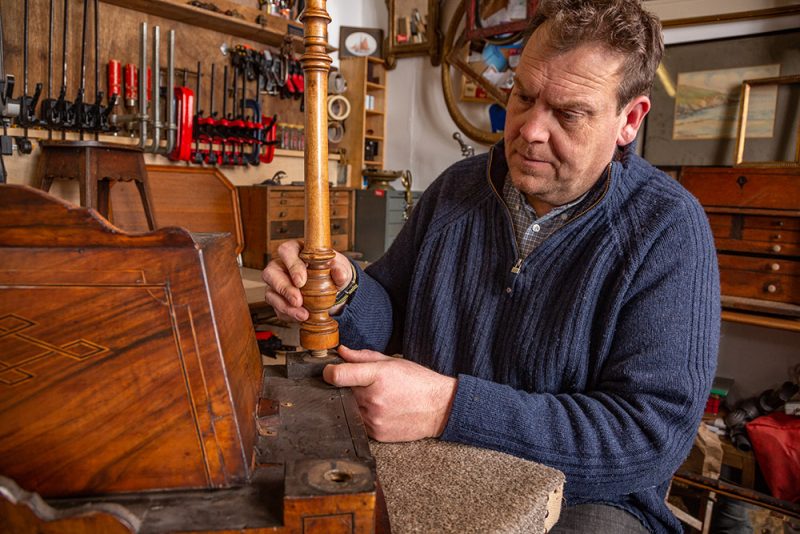
Strength and delicacy of touch are required attributes
Paul encountered some wayward behaviour, but also many good restorers and dealers with integrity. Fortunately, he says, he knew from early on ‘that perfection and the right way of doing things was the right thing for me.’ His YTS experiences included a stint as an auction porter at the Canterbury Auction Galleries, training at the London College of Furniture, where his travel expenses were twice as much as his wages, which the boss kindly boosted, and attending courses on wood graining at West Dean. Paul did lots of sanding down, lots of preparation and learnt how to sharpen chisels and look after old wooden tools. While on a YTS placement in Chatham Dockyard he bought an old shipwright’s box. ‘It was full of tools,’ he says. ‘Everything was covered in Vaseline to keep it from rusting.’
After the YTS placements, Paul worked for several restorers on a self-employed basis before setting up his own business. In 2002, he took ten years out to be a teaching assistant in local primary schools. He worked for four years in Graveney and six in Davington. ‘I wanted a break – it was a career move sideways.’ ‘I was quite passionate about the job,’ says Paul, ‘and did an NVQ’ (National Vocational Qualification). When an incoming Head made a large number of staff redundant, Paul went back to furniture restoration, refreshed by his time in teaching.
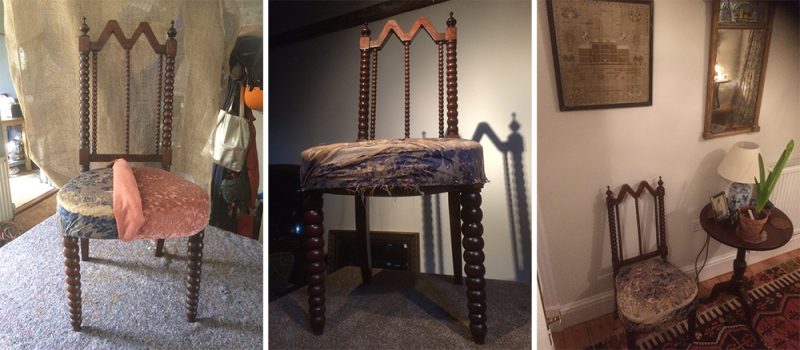
A Regency rosewood chair with bobbin-turned legs: its inappropriate seat upholstery; the original fabric revealed; the chair in its new home
He has found the ideal home for his business. The Branching Out premises, a former motorcycle showroom, are a warehouse-like space that provides a perfect stage set for antiques. It is the brainchild of Sophie Norton and Judith Monk. They have gathered together some excellent specialist dealers, 12 in all, counting Paul. Their stock includes French decorative antiques, industrial artefacts, unusual vintage objects for the home and garden, distressed painted furniture and all sorts of irresistible large and small items. ‘It’s a very sociable place,’ says Paul. He does work for colleagues as well as the general public – a regular request from Sophie is: ‘Can you repair this, Paul?’ He very probably can.
Ménage à Bois and the Branching Out Antiques Centre are open on Monday and Wednesday to Saturday from 10am to 4.30pm; closed Tuesday and Sunday, except for the first Sunday of the month when the Faversham Antiques and Vintage Market is on. The address of both is:
39A The Mall
Faversham
ME13 8JN
Tel: 07857 554747
Email: phtucker43@icloud.com
www.branchingoutantiques.co.uk
Contact Judith or Sophie on 07742 117815
Email: enquiries@branchingoutantiques.co.uk
Words: Sarah Langton-Lockton. Photographs: Neil Brown and Paul Tucker